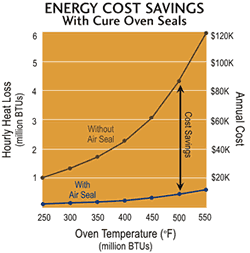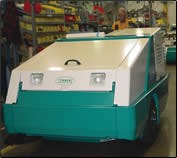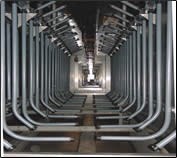Three Steps to Lower Energy Use
Improve paint system bottom line by cutting energy consumption
#basics #curing #energy
As manufacturers in all industries struggle to stay competitive in a challenging economic climate, many companies are looking to energy savings as a way to improve their bottom line. New energy saving technologies and processes available for deployment in powder coating and paint systems are enabling companies to reduce operating costs and improve profit margins.
Annual energy costs have nearly tripled in recent years, directly impacting plant overhead and profitability. In a manufacturing assembly plant, the finishing department is often one of the largest energy users—in fact, many companies have found that the finishing process can account for half of all the energy consumed by the entire plant. This realization, coupled with skyrocketing natural gas costs, is causing manufacturers to realize the importance of making finishing systems more energy-efficient.
Featured Content
An approach that has worked well for many manufacturers interested in cutting energy consumption in their finishing operations is a three-step process to minimize high-temperature operations, contain heated air, and upgrade process automation and control. This article examines each of these three steps and the type of savings that might be possible from each.
Step 1: Minimize High-Temperature Operations
Significant energy is consumed during the finishing process by heating parts and chemicals to a high operating temperature. Making system changes that enable effective operation at lower temperatures provides significant energy savings.
In the cleaning and pretreatment system, for example, chemicals are typically sprayed on the parts to be painted to remove oils and organic components and prepare the part surface for finishing. A large amount of energy, usually in the form of natural gas, is required to heat the cleaning and pretreatment chemicals to a high operating temperature. Selecting chemicals that operate effectively at lower temperatures can cut energy usage.
For example, a typical washer might use chemicals that work best at an operating temperature of 140°F. Operating at this temperature in a large washer would consume about 2.5 million Btu/hr.
New cleaning and pretreatment chemicals are available with an effective operating temperature of 110°F. Operating at this lower temperature would consume about 1 million Btu/hr. At an energy cost of $10 per million Btu, this reduction in energy usage of 1.5 million Btu/hr provides a savings of $30,000 every year. This cost saving assume system operation on a single eight-hr shift for 250 days/yr; operating on multiple shifts would double or triple the savings.
Other obvious high-temperature areas of the finishing process are in curing and in burn-off. Cost savings can be achieved in both areas. In a powder coating system, energy savings can be accomplished by selecting a powder that cures at a lower temperature. For example, using a powder or paint material that enables the cure oven to run at 75°F lower temperature can save 600,000 Btu/hr, providing annual savings of more than $15,000.
Similar savings can be achieved in pyrolytic burn-off ovens used to clean part fixtures and racks. Available new patented technology enables lowering the oven’s operating temperature and also achieving faster cycle times. This is accomplished by creating a high-humidity, low-oxygen environment. The high density of airborne water particles significantly increases the oven air’s heat-carrying capacity and increases heat transfer efficiency, allowing fixtures and racks heat up much faster than in a conventional burn-off oven.
This new process also provides additional benefits. The low-oxygen environment helps prevent fires and flare-ups, thus extending fixture and rack life by minimizing thermal shock. Eliminating fires in the burn-off oven also eliminates the need for water spraying the parts to put out the fires, thus minimizing ash and cleanup.
Step 2: Contain Heated Air
Heated air in the washer and ovens can escape through the work openings into the surrounding plant. Preventing this air from escaping can not only cut energy costs but also improve finish quality.
As the name suggests, our company’s patented Air Barrier heat seal technology creates an air barrier at the oven work openings. Essentially, air seals perform like a physical curtain, but in actuality the curtain is made of blown air.
The technology works by drawing hot oven interior air and compressing it using scroll fans. Centrifugal fans are used to force the air into the open work openings. The pressure differential between the factory environment and the oven interior keeps the hot oven air from entering the factory.
When the air seals are installed, parts reach cure temperature much more quickly than in a conventional curing oven, and they stay at cure temperature for a longer time. Therefore, if adequate cure was being achieved without air seals installed, then installation of air seals should enable one of the following:
- Shorter oven length
- Faster conveyor speeds
- Reduced oven cure temperature.
Installation of this technology can significantly reduce energy costs associate with curing by containing heated air in the oven and avoiding the cost of re-heating new air. The air seal also prevents fumes from the interior of the oven from escaping into the surrounding plant. Annual savings of about $50,000 can be achieved when air seals are installed on an oven operating at 450°F.
Step 3: Automation and Control
Automatically monitoring and controlling the finishing process can cut energy consumption as well as provide numerous other benefits. Advanced process controllers provide a comprehensive view of paint system operations. They enable engineers and managers to monitor every stage of the finishing operation, including the washer, finishing booth, and ovens. As conditions vary from pre-defined ideal conditions, the controller adjusts operating parameters to ensure effective product cleaning, conversion coating and curing at a consistent high quality level.
This optimized operating environment streamlines the finishing system. The controller maintains ideal chemical concentrations, temperatures and other process parameters, thus improving coating adhesion, finish quality and first-pass yields. Minimizing rework not only saves the labor and production time associated with removing the defective paint and re-running the part through the finishing system, but also saves the energy associated with doing so.
Our company’s process control products are used to control and manage specific elements of the paint finishing line, including pretreatment, spray booths and the curing oven. In addition to increasing quality and improving line efficiency, automated process control with real-time tracking capability also supports six sigma and continuous improvement initiatives by providing a wealth of process data for analysis.
New or Retrofit
These three steps to reduce energy consumption can be taken when specifying a new finishing system, or they can be used to retrofit existing finishing lines.
When the Tennant Company (Minneapolis, MN), a supplier of industrial sweepers and maintenance products, was looking to upgrade its finishing system, engineers were not only able to switch from liquid paint to powder coating, but they also implemented several energy saving technologies described in this article.
Tennant realized multiple operating and quality benefits as a result of the upgrade. Part quality significantly increased, and, along with our company, Tennant won an Energy Partnership Award from the Energy Solutions Center Inc. (ESC; Washington, DC). ESC is a national nonprofit consortium of energy utilities, municipal energy authorities and equipment manufacturers that helps promote use of new, energy-efficient, natural gas-fueled technologies for industrial and commercial applications. The award recognized Tennant’s innovative industrial paint system technology and processes used in the system that cut energy usage by more than 25%.
For retrofits, we offer modular kits that can be used on existing industrial finishing systems to reduce energy consumption and achieve a fast payback. Common upgrades are:
- Air Barrier heat seal kits
- Oven upgrade kits
- Automated powder system controllers
- Pretreatment washer upgrade kits
- Air management upgrade kits.
Oven upgrades, for example, save energy and improve cure, dry-off and cleaning cycles by dynamically adjusting the oven environment to changing external conditions and varying part thickness and type. They can also enable continuous in-line processing, correct airflow problems, contain smoke and perform on-board diagnostics to help prevent future problems.
One John Deere plant recently upgraded its paint finishing system, including conversion of a batch-oriented system to an in-line enclosed system, cure oven air seals and an air management system. The upgrade reduced energy consumption and also provided a variety of other benefits. According to a John Deere spokesman, the upgrade “increased paint finish quality, lowered labor and operational costs, increased production capacity and enabled us to process multiple products. Our plant utilization has significantly increased.”
RELATED CONTENT
-
Painting a Boeing 737: See The Video
The cost is between $100,000 to $200,000 to prep and paint each plane, depending on which colors are chosen, and how many colors.
-
Troubleshooting Bubbles in Powder Coating
How can I get rid of these bubbles in powder coating?
-
Are TGIC-Free Powder Coatings Right For You?
This alternative to TGIC-based polyester powder coatings offers similar performance and enhanced transfer efficiencies.





















